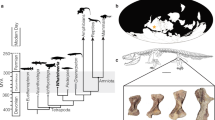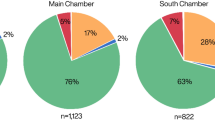Abstract
After observation of detailed structural evidence for the origin of birds from dinosaurs1, and in light of evidence that dinosaur bone tissue resembles the histology in mammals2, the histology of bone has become one of the focal points in discussions of the physiology of dinosaurs and Mesozoic birds3,4,5,6,7,8,9,10. Most of this microstructural information has focused on features related to the vascular organization and the amount of remodelled bone around vascular canals. However, the finer structures have received less attention, although differences in such structures have been observed among modern vertebrates10,11. Here we present evidence that canaliculi—the submicrometre-sized channels that interconnect bone cells and vascular canals—and the collagen fibre bundles in bone are differently organized among certain dinosaur lineages. Ornithomimid dinosaurs12 are more like birds than mammals in these features. In canalicular structure, and to some extent in fibre bundle arrangement, ornithischian dinosaurs are more like mammals. These differences in both canalicular and lamellar structure are probably linked to differences in the process and rate13 of bone formation.
This is a preview of subscription content, access via your institution
Access options
Subscribe to this journal
Receive 51 print issues and online access
$199.00 per year
only $3.90 per issue
Buy this article
- Purchase on Springer Link
- Instant access to full article PDF
Prices may be subject to local taxes which are calculated during checkout





Similar content being viewed by others
References
Ostrom, J. H. The ancestry of birds. Nature 242, 136 (1973).
Enlow, D. H. & Brown, S. O. A comparative histological study of fossil and recent bone tissue. Part II. Tex. J. Sci. 9, 186–214 (1957).
Currey, J. D. The histology of the bone of a prosauropod dinosaur. Palaeontology 5, 238–246 ( 1962).
Bakker, R. T. Anatomical and ecological evidence of endothermy in dinosaurs. Nature 281, 81–85 ( 1972).
de Ricqlès, A. in A Cold Look at the Warm-Blooded Dinosaurs (eds Thomas, R. D. K. & Olson, E. C.) Ser. 28, 103–139 (Amer. Assoc. Adv. Sci. Selected Symp., Westview Press, Boulder, 1980).
Reid, R. E. H. The histology of dinosaurian bone, and its possible bearing on dinosaurian physiology. Symp. Zool. Soc. Lond. 52, 629 –663 (1984).
Reid, R. E. H. On supposed Haversian bone from the hadrosaur Anatosaurus, and the nature of compact bone in dinosaurs. J. Paleont. 59 , 140–148 (1985).
Chinsamy, A. Physiological implications of the bone histology of Syntarsus rhodesiensis (Saurischia: Theropoda). Palaeont. Afr. 27, 77–82 (1990).
Varricchio, D. J. Bone microstructure of the upper Cretaceous theropod dinosaur Troodon formosus. J. Vert. Paleont. 13, 99–104 (1993).
Gebhardt, W. Über funktionell wichtige Anordnungsweisen der feineren und gröberen Bauelemente des Wirbeltierknochens. II. Spezieller Teil. 1. Der Bau der Haversshen Lamellensysteme und seine funktionelle Bedeutung. W. Roux Archiv für Entwicklungsmechanic der Organismen 20, 187 –334 (1906).
Amprino, R. & Godina, G. La struttura della ossa nei vertebrate. Ricerche comparative negli amfibi e negli amnioti. Commentat. Pontif. Acad. Scient. 11, 329–463 (1947).
Sereno, P. C. The evolution of dinosaurs. Science 284, 2137–2147 (1999).
de Ricqlès, A., Meunier, F. J., Castanet, J. & Francillon-Vieillot, H. in Bone 3, Bone Matrix and Bone Specific Products (ed. Hall, B. K.) 1–78 (CRC, Boca Raton, Florida, 1991).
Curtis, T. A., Ashrafi, S. H. & Weber, D. F. Canalicular communication in the cortices of human long bones. Anat. Rec. 212, 336– 344 (1985).
Pawlcki, R. Metabolic pathways of the fossil dinosaur bones Part III. Intermediary and other osteocytes in the systems of metabolic pathways of dinosaur bone. Folia Histochem. Cytobiol. 22, 91– 98 (1984).
Gauthier, J. in The Origin of Birds and the Evolution of Flight (ed. K. Padian). Mem. Calif. Acad. Sci. 8, 1–55 (1986).
Holtz, T. R. The phyletic position of the Tyrannosauridae: implications for theropod systematics. J. Paleont. 68, 1100– 1117 (1994).
de Ricqlès, A. Recherches paléohistologiques sur les os longs de Tétrapodes. VII. Sur la classification, la signification fonctionnelle et l'histoire des tissues osseux des Tétrapodes. Partie 1. Ann. Paléont. (Vertebres) 61, 51–129 ( 1975).
Pawlcki, R., Korbel, A. & Kubiak, H. Cells, collagen fibrils and vessels in dinosaur bone. Nature 211, 655–657 (1966).
Rimblot-Baly, F., de Ricqlès, A. & Zylberberg, L. Analyse paléohistologique d'une série de croissance partielle chez Lapparentosaurus madagascariensis (Jurassique moyen): essai sur la dynamique de croissance d'un dinosaure sauropode. Ann. Paléont. (Invert. - Vert.) 81 , 49–86 (1995).
Amprino, R. La structure du tissu osseux envisagée comme expression de différences dans la vitesse de l'accroissement. Arch. Biologie 58, 315–330 (1947).
Giraud-Guille, M. M. Twisted plywood architecture of collagen fibrils in human compact bone osteons. Calcif. Tissue Int. 42, 167– 180 (1988).
McMahon, J. M., Boyde, A. & Bromage, T. G. Pattern of collagen fiber orientation in the ovine calcaneal shaft and its relation to locomotor-induced strain. Anat. Rec. 242, 147–158 (1995).
Raspanti, M., Guizzardi, S., Strocchi, R. & Ruggeri, A. Collagen fibril patterns in compact bone: preliminary ultrastructural observations. Acta Anat. 155, 249–256 (1996).
Castanet, J., Grandin, A., Abourachid, A. & de Ricqlès, A. Expression de la dynamique de croissance dans la structure de l'os périostique chez Anas platyrhynchos. C. R. Acad. Sci. Paris 319, 301–308 (1996).
Boyde, A. in The Biochemistry and Physiology of Bone (ed. Bourne, G.) 259– 310 (Academic, New York & London, 1972).
Currey, J. D. The Mechanical Adaptations of Bones (Princeton Univ. Press, Englewood Cliffs, New Jersey, 1984).
Martin, R. B. & Burr, D. B. Structure, Function, and Adaptation of Compact Bone Fig. 2. 4. (Raven, New York, 1989).
Crawford, G. N. C. The evolution of the Haversian pattern in bone. J. Anatomy 74, 284–299 (1940).
Xu, X., Tang, Z. -L. & Wang, Z.-L. A therizinosauroid dinosaur with integumentary structures from China. Nature 399, 350– 354 (1999).
Acknowledgements
We thank J. Ostrom for identifying two ornithomimid specimens; S. Herring, A. de Ricqlés, M. Smith and N. Wolf for assistance with the manuscript; and B. Evans, S. McCallum, D. McDougall, S. Ott-Ralph and D. Sherrard for helpful discussion. A. Busbey, P. Currie, G. Erickson, J. Joslin, A. Kemp, O. Rieflin, S. Rohwer, H.-D. Sues, C. Wood and the Woodland Park Zoo kindly made specimens available. B. Witte collected and prepared dinosaur specimens; S. Andres, D. Bennett, G. Bergsma, V. Carr, C. Chihara, J. Cyrus, M. Dyakanoff, J. Haag, H. Heller, M. Hoffman, N. Huston, D. Jacobson, K. Jensen, J. Johnston, J. Kim, K. Krigbaum, T. Lee, B. Leu, M. Mielkey, B. Moorthy, J. Morton, E. Moye, H. Mull, J. Nguyen, B. Olsen, C. Pardo, L. Rende, O. Rieflin, L. Ruhwedel, T. Schommer, M. Shields, A. Smith, B. Summers, T. Ting, H. Wada, J. Weber and H. Witt ground thin sections or helped in other aspects of the study. We are grateful to the Burke Museum, the Hayashibara Museum, the University of Washington College of Arts and Sciences, and Departments of Geological Sciences and Orthodontics for support.
Author information
Authors and Affiliations
Corresponding author
Rights and permissions
About this article
Cite this article
Rensberger, J., Watabe, M. Fine structure of bone in dinosaurs, birds and mammals. Nature 406, 619–622 (2000). https://doi.org/10.1038/35020550
Received:
Accepted:
Issue Date:
DOI: https://doi.org/10.1038/35020550
This article is cited by
-
Calcium orthophosphates (CaPO4): occurrence and properties
Progress in Biomaterials (2016)
-
Osteocyte Shape and Mechanical Loading
Current Osteoporosis Reports (2015)
-
Toughening mystery of natural rubber deciphered by double network incorporating hierarchical structures
Scientific Reports (2014)
-
The Osteocyte as an Orchestrator of Bone Remodeling: An Engineer’s Perspective
Clinical Reviews in Bone and Mineral Metabolism (2014)
-
Biomechanical aspects of bone microstructure in vertebrates: potential approach to palaeontological investigations
Journal of Biosciences (2009)
Comments
By submitting a comment you agree to abide by our Terms and Community Guidelines. If you find something abusive or that does not comply with our terms or guidelines please flag it as inappropriate.



